Painting Poems – Watch the Video!
This week, we’ll continue the theme of painting poems from a couple of weeks ago. I create a small painting from a poem in a video and also talk about overcoming perfectionism.
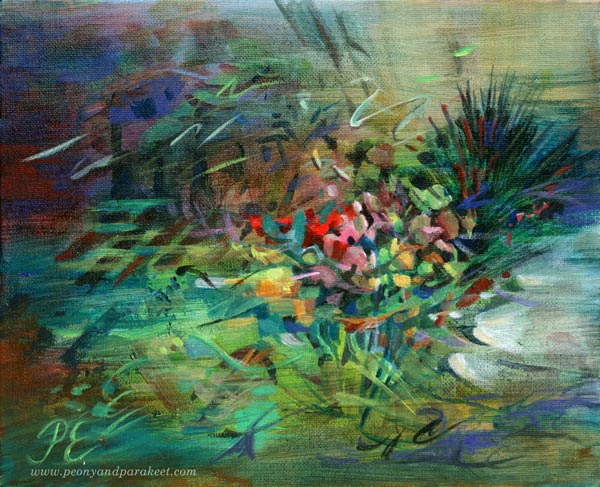
Here’s the acrylic painting that I created from Saima Harmaja‘s old poem “Olkoon niin!” I also include some examples from the class Floral Freedom at the end of this post.
Painting Poems – Watch the Video!
In the video, I show how a poem can make a painting more finished and meaningful. I also talk about why I thought I can’t paint Finnish poems and how I have realized that aiming for perfection doesn’t always help.
More Poetic Paintings
I created these two paintings for the class Floral Freedom. The first one is inspired by Anna-Maija Raittila’s poem Ruiskukkaehtoo (Cornflower Night).
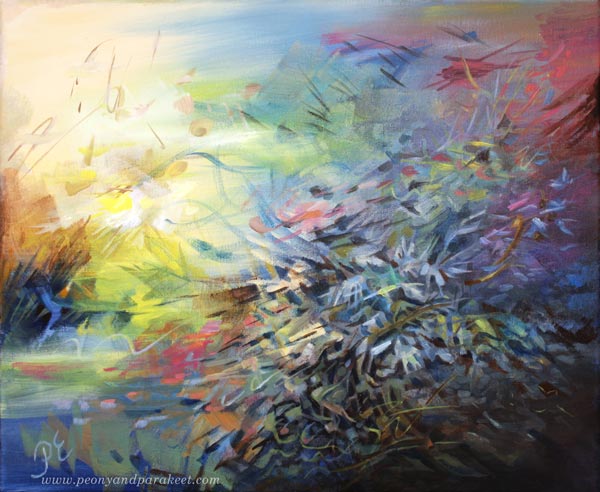
And the one below is inspired by Katri Vala’s poem Kukkiva maa (Flowering Earth).
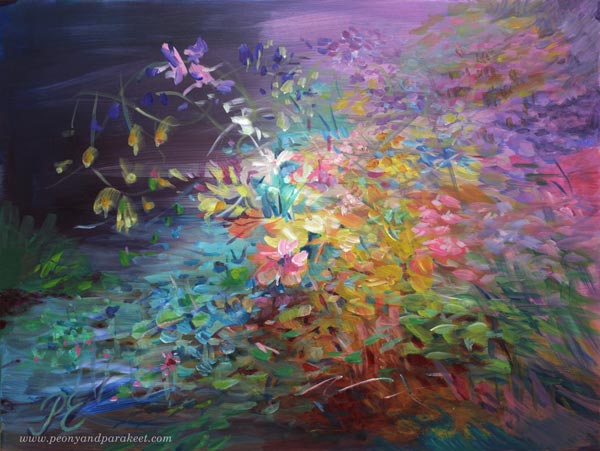
Paint Dreamy Florals to Free Your Spirit!
Floral Freedom – the abstract floral class based on Paul Klee’s and Wassily Kandinsky’s insights – will begin on Dec 4, 2021. In this class flowers are not just passive decorations, but they fly, sing, and dream! >> Sign up Now!
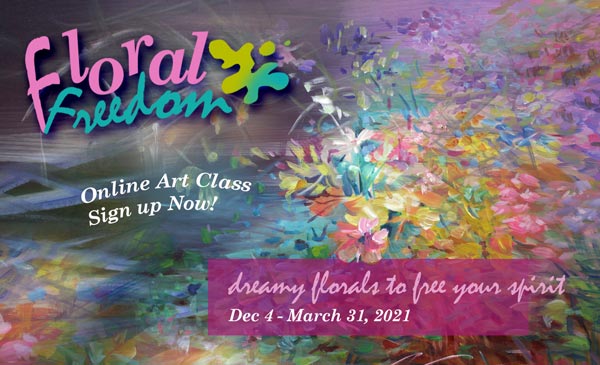
Floral Freedom is 20% off for the rest of November, so now is a good time to sign up!
>> Sign up now!
Using Leftover Paint – Messy Backgrounds and Beyond
This week, I show one of my art journals in the video and share ideas for what to create from messy backgrounds.
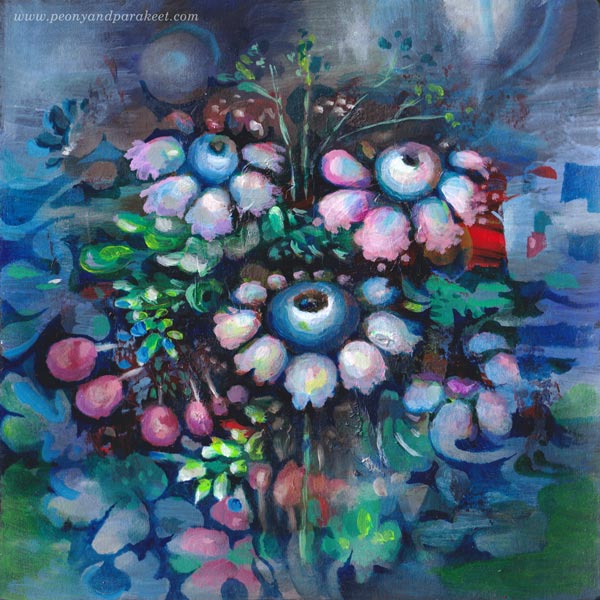
After a painting session, there’s usually some leftover paint on a palette. I try to squeeze the tubes carefully, and sometimes I put the paint in a box with a lid, but most often, I grab an art journal and wipe off the extra paint from the brushes and palette. If I am tired, I just spread the paint carelessly. If I still have energy, I add details to a page that already has some color. When I don’t like something in the next session, I paint new strokes over it.
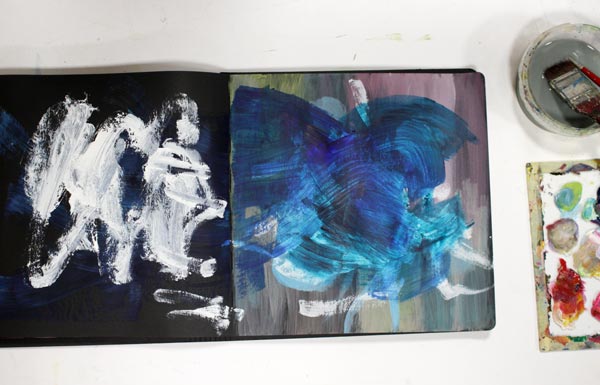
Many Rounds – Some Quicker than Others
I rarely make a page at one go. This spread has oil paints, and it took ages to finish it. But it didn’t matter, because I was practicing for the class Decodashery, and I needed time to dig into the heart of decorative painting style.
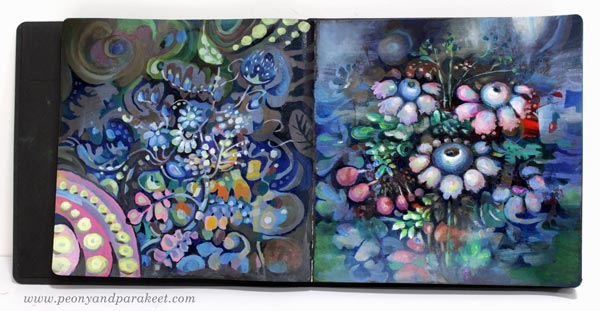
However, the one below is more abstract, and it was really quick!
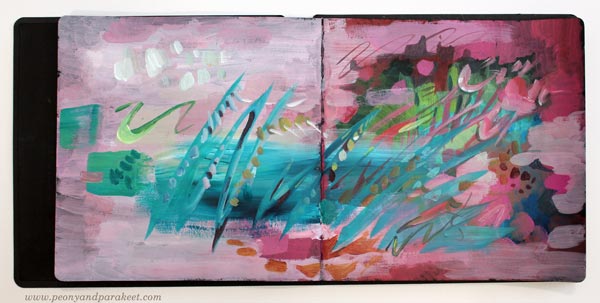
Messy Backgrounds and Beyond – Watch the Video!
In the video, I show messy pages and not so messy pages of my current art journal and how I finished the spread above. Watch the video!
Even if bigger paintings are my main work, art journal pages are an important part of my creative process. It’s like yin and yang! I need the mess-making to find joy in working with details.
Art Inspired by Music
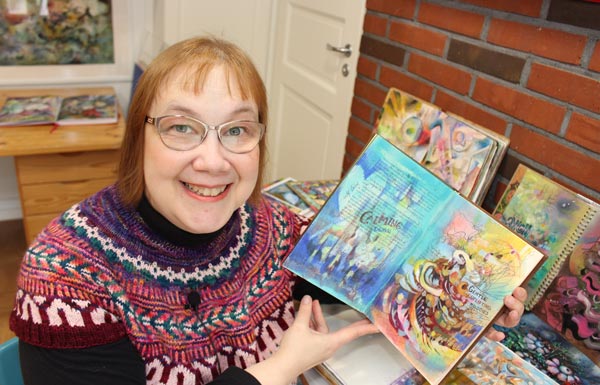
In the video, I mentioned the idea of visualizing a musical landscape and a melody. Music is the theme in my mini-course for Gratitude Junk Journal 2020 as well. This online workshop has 12 instructors, and it begins on Nov 1st, 2020. Register in October to get 20% off. Enter JOY2020 at checkout. >> Buy Here!
Paint a Poem!
This week, we’ll talk about poems and how to turn them into paintings!

This acrylic painting is called “Terät liitävät kirsikkapuista,” and it’s my interpretation of Valter Juva’s poem from 1902.
The Finnish name is a bit difficult to translate. Terät liitävät have a double meaning: 1) blades flying in the air 2) petals falling freely. Namely, a petal – terälehti – is a compound word in Finnish. Terä is a tip or a blade. Lehti means a leaf.
This is not the only language-related thing in the poem, and I struggled with the translation. But here’s the best I could do!
English Translation of Valter Juva’s Poem
| Terät liitävät kirsikkapuista, ja virta vieno ne vie. Se tyynine suvantoineen mun onneni kymi lie. | Edges fall from cherry trees and are caught by a gentle stream. The river and its pools are the well of my serene. |
| Suviyössä, mi tuoksuu ja värjyy, veet kultahan sulautuu; se lekkuu lännessä päivä ja idässä kuultaa kuu. | In the summer night, that smells and glows, waters melt in gold; in the west, the day is stirring, and in the east, shines the moon. |
| Niin hiljaist’ on ja tyyntä! Ja koskien alla veet ne ahtaassa piirissä viipyy, mut siinä on syvenneet. | It’s so quiet and calm! And under the rapids, waters dwell in a tight round but have become deeper and deeper. |
Passion for Poetry
When I was a teenager, poems were my passion in the same way drawing and painting have been. I used to read poetry, and almost daily, wrote my own. I even entered competitions, and some poems have been published. Later, this love for poems have reappeared occasionally: I have read or written some. In 2014, I even wrote a blog post about illustrating poems in art journaling.
But now, it feels that poetry has come to stay. Every time I open a big book (Runojen kirja – Book of Poems) that I won in a poem-writing competition in 1981, I see something that I want to paint. The book has over 800 pages filled with four centuries of Finnish poetry, but it’s not just that. With the book, I remember many poets that I used to read. My mind is blowing, and my brushes are jumping! “Paint paint paint,” they cry!
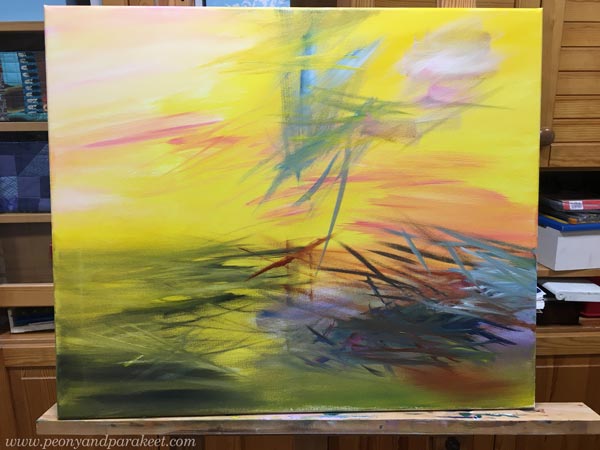
Valter Juva’s poem was new to me, but I got inspired right away. This painting has a lot of yellow in the background!
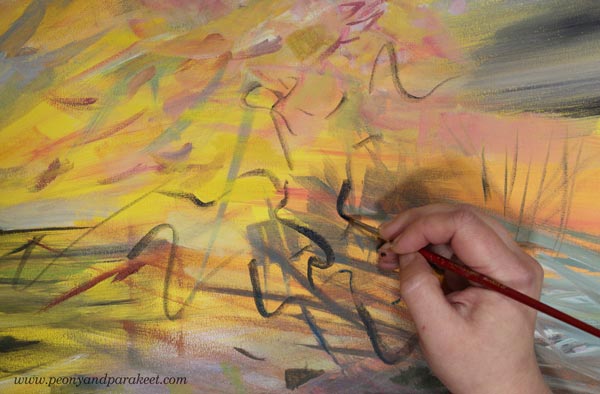
It was a joy to paint those sharp petals and curvy cherry trees that so willingly release the flowers. The size of this painting is 50 x 60 cm (about 19,5 x 23,5 inches) so I was able to paint the details more roughly and quite quickly.
Paint a Poem – Trust the Inspiration!
Painting a poem doesn’t have to be about illustrating every word. It can be more about finding a personal view – how the poem loosely explains your current life and often past experiences too.
In Valter Juva’s poem, the connection between Japan (cherry trees) and Finland (bright summer nights) blew my mind. You who have read my blog for a long time, know that both my husband and I love everything Japanese, and we also have a Japanese garden.
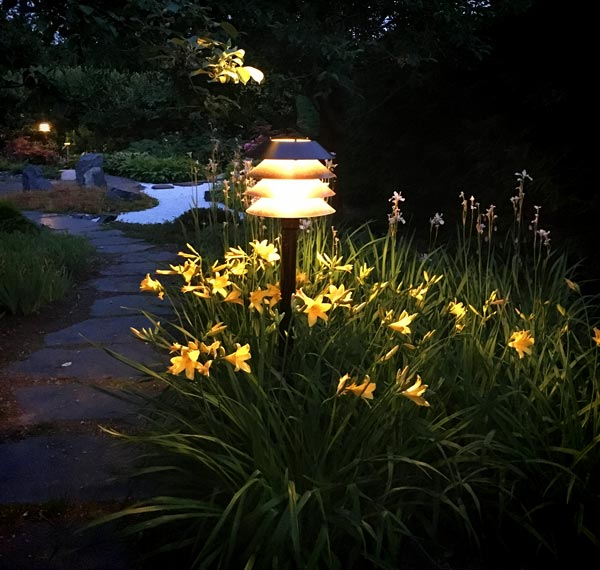
White nights were magical last summer! East and west meet like in the poem!
Paint a Poem – Color the Words!
Poems are filled with interesting words that can have a double meaning or a specific nuance. We don’t even have to know what strange words actually mean. It can still have a certain feeling to us, and we can express that with colors and shapes.

In Valter Juva’s poem, there’s a Karelian word lekkuu which means moving or stirring. To me, it has a relaxed undertone which makes me think about yellow-orange curves floating in the air, just above the water.
Paint a Poem – Break Borders!
In art, whether it’s poetry or painting, we can break borders. We don’t have to stick with one geographic location but create one that has characteristics of several places. Similarly, we are allowed to freely travel in time, from childhood to ancient history, and from the current moment to fantasy.
By changing the rules of reality, we can make representational elements symbolize more abstract things. They can be inanimate objects or nature’s elements, for example. In Valter Juva’s poem, waters have deep knowledge, In my painting, static trees take off and timid flowers jump from the plane.
Also, we can be magicians and make any material change its state. In the poem, water becomes gold, and in my painting, light is less immaterial and more touchable and concrete.
Poems are filled with metaphors, so why not let them in your paintings too!

Which poem would you like to paint?
Kaiho – Painting the Longing
This week, I talk about the Finnish word “kaiho” and how art can bring up deeper longings than we first realize.
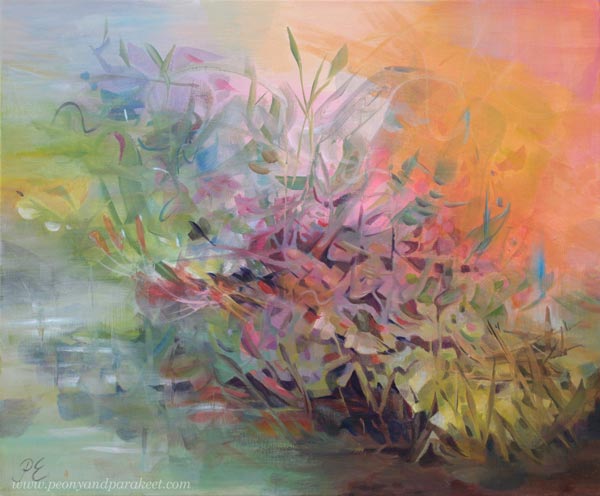
I created this acrylic painting at the end of September. It’s called “Sammumaton kaiho” which is something like “Unquenchable Longing” or “Extinguishable Longing” in English, but I think that this time, the Finnish name is much better.
Kaiho is one of the most heart-breaking words that I know. It’s not like kaipaus (yearning) but something much quieter. And being a short word, it’s like a whisper in the air.
Say it softly with me: “kaiho” (kaaiihoh)…
It feels like a piece of a deep agony flies away with the word. Maybe every language has these kinds of soothing kaihos that don’t belong to the daily vocabulary, but that need to get out now and then.
Quick Start with Happy Colors
I started the painting by filling the canvas with candy colors. With a big brush, it was quick and fun.
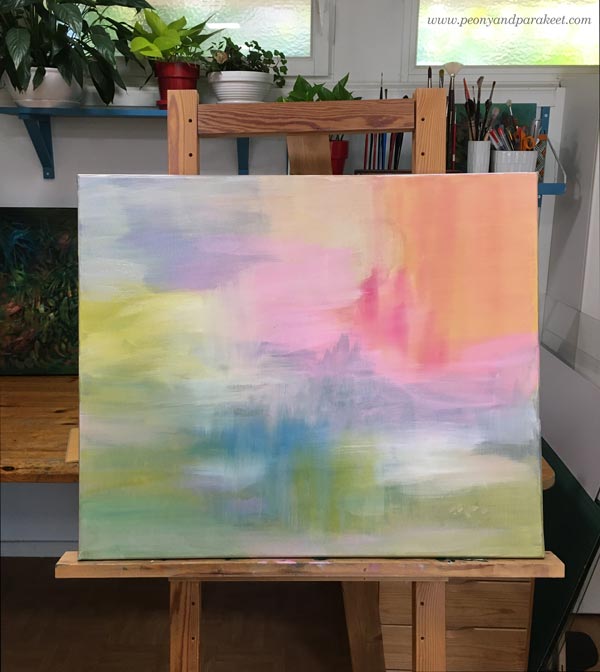
I didn’t overthink the subject, but painted plant-like shapes and tried to enjoy the process as much as possible.
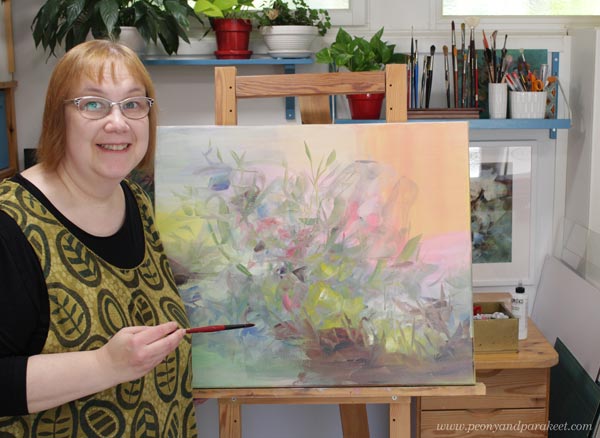
In the photo above, the painting is still quite young. But it progressed quickly!
Finlandia Raised the Longing
It was Friday evening when I was adding final touches to the painting. At the same time, I was watching – well listening to – Voice of Finland. It’s a singing contest, pretty similar to American Idol.
Even if all the songs are usually rhythmic pop songs, one singer had chosen differently. He sang Finlandia, a hymn, instead. Every Finn knows Finlandia, and it brings many stereotypical images to mind: forests, lakes, swans, snow, blue, white. I have heard the song thousands of times. But this time, I was painting too, and it always boosts my senses.
Do You Know Finlandia?
The song is composed by Jean Sibelius in 1899, and a poet V.A Koskenniemi has written the lyrics.
>> Here’s a great article about Finlandia, including an English translation for the lyrics.
Watch BBC Symphony Chorus and the BBC Symphony Orchestra conducted by Finnish Sakari Oramo, play the song.
Remembering What’s Lost
With Finlandia, I was reminded of what I no longer have. As a child, I lived in Karelia, Eastern Finland, near the Russian border. Finland lost a part of it in a war in 1940, and it has left its marks on future generations as well. But personally, the bigger loss was leaving Karelia to study engineering, and quickly after that, losing my mother.
Here’s an earlier picture of me, my mother, and a close friend Saimi Norimäki. Saimi was born in Western Finland, and she was much more straight-forward and brave than what we had used to see. But she was a woman with a warm heart, and I have many fond memories of her.
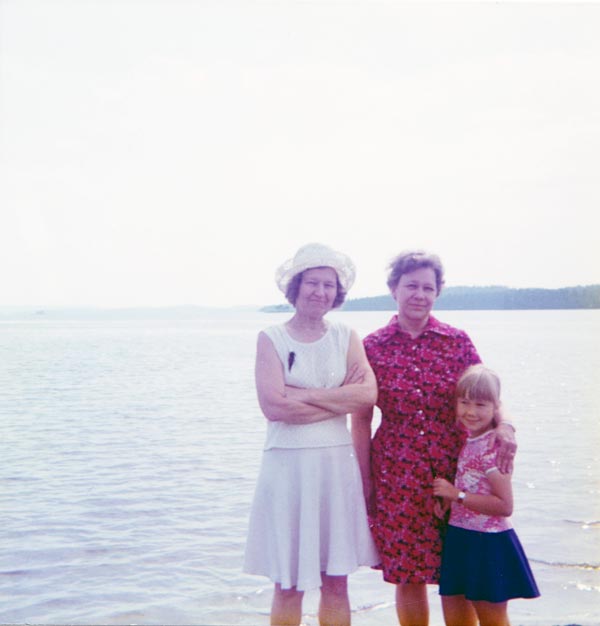
This photo is a good representation of the sadness that I have. The colors have faded away, there’s a lot of empty space, but I still remember the people.
A More Joyful Longing
However, when painting along with Finlandia, I was able to dig through the sadness and find the longing that was more joyful. I asked myself: “What are you painting, Paivi?” The answer came quickly:
“I paint what I know best – what it is like to walk on Karelian meadows on a hot summer day, how the warm and rough ground feels, and how the soil smells. I know what the heart of Karelia is, its temperament, culture, and nature.”
I also remembered many old Finnish songs, poems, places where I used to go as a child, and the word: kaiho.
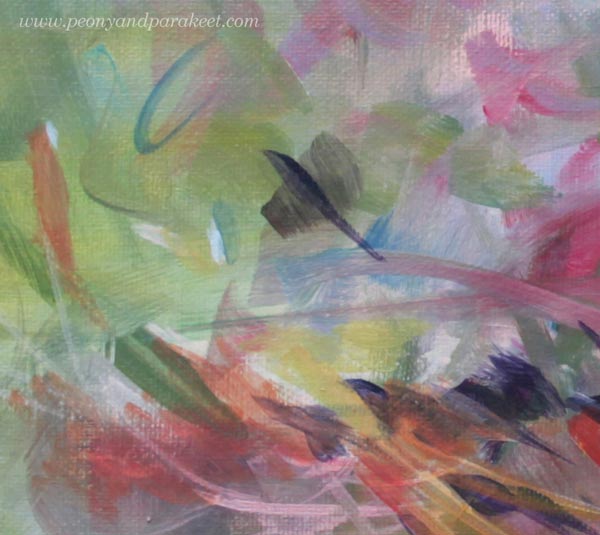
They say that Karelian people often laugh and cry at the same time. We tend to get caught by emotions, and easily see polarities in them. So even if my painting has happy colors, it also has this kaiho, this longing, that’s unquenchable – that never leaves me.
I now believe we all have layers of longings. Under a sad layer, there can be a more joyful one. In a global world, each of us has many identities, many cultural impacts, and it’s easy to forget some of them. So when creating, we are not purely painting the longing what we are consciously aware of, but how we are truly built. With this natural integration, art has the power to make us feel more whole and grounded.
Finished Painting

“Is this the painting that needs a hanging wire,” my husband asked pragmatically the next morning.

When weather allows, I photograph my paintings outside.
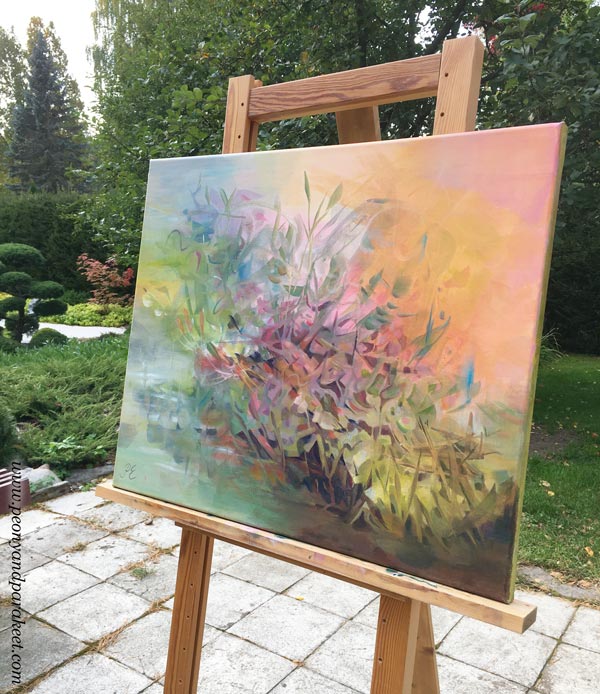
This painting is 54 x 65 cm – about 21x 25,5 inches.
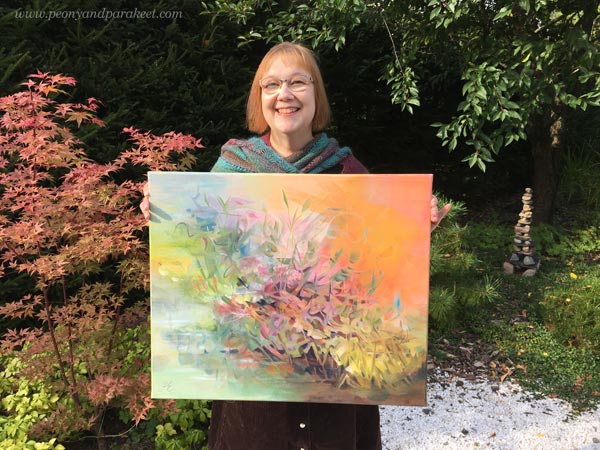
My Journey of Painting the Longing Continues
As a young woman, my mother got a book of poems which I now have. The book is called Ruiskukkaehtoo (Cornflower Night), and it’s written by Anna-Maija Raittila.
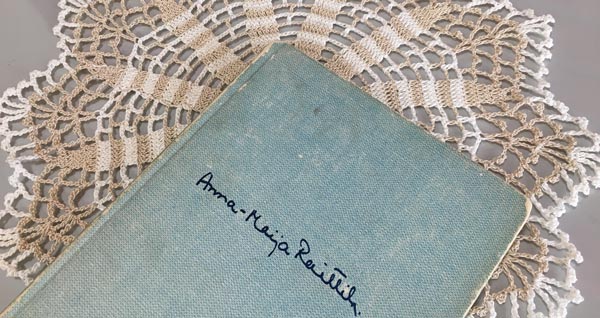
Ruiskukkaehtoo is also one of the poems, and my goal is to paint that! Not so much to illustrate the poem itself, but to express what comes to my mind from it. Even if it’s a poem and not a song, it has a captivating rhythm. I am pretty sure it will take me back to painting the longing.
Create with Me!
- See the new free mini-course Paint the Emotion! The painting of this post was made with pretty similar techniques.
- Stay tuned for a new class! I am working on the new class Floral Freedom. It’s about painting freely by using the principles of Paul Klee and Wassily Kandinsky. The registration will open in November.
- Sign up! Does music play a big role in your art-making? Sign up for Creative Junk Journal 2020 to get my mini-course about expressing your favorite music!